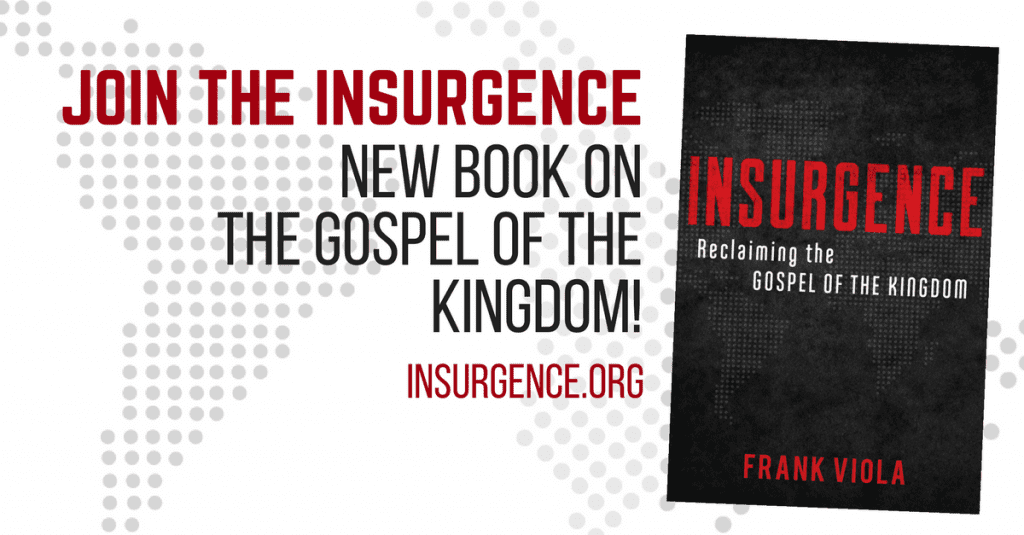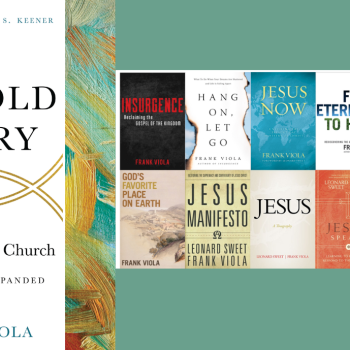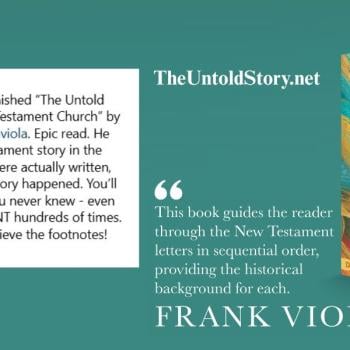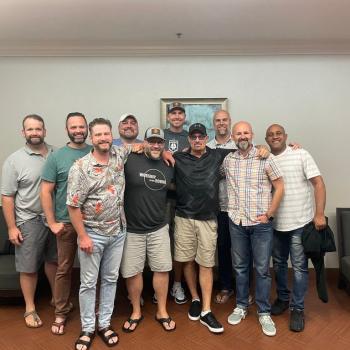I recently interviewed the authors of the new book, Slow Church. From the title, I thought this would be a book on radical ecclesiology, dealing with things like church leadership, structure, the clergy-laity dichotomy, the purpose of the church meetings, every-member functioning in the gatherings, expressing Jesus Christ corporately, etc. But it really doesn’t explore those themes. Thus it’s not a book in the same genre as Reimagining Church or The Normal Christian Church Life or Paul’s Idea of Community or 0-58.
What it does do, however, is decry the “industrialized, fast-food approach” to Christianity. Hence, the book is more a discussion on certain values that Christians (they use the word “church” to describe believers in general as well as local communities) should embrace. Some of the chapter titles are ethics, patience, work, Sabbath, gratitude, hospitality, etc. These virtues should be operating in every believer’s life as well as in the local asssemblies of which they are part, say the authors. Christianity shouldn’t be relegated to the privacy of one’s own home. My take on the book is that it’s more missional (focusing on outward witness) than it is ecclesiological. The authors are dead right — modern Christianity is way too fast(food) paced! Slowness is a virtue, just as stillness is.
The book reminded me very much of The New Parish, as it seems to be coming from the same perspective and made many of the same points.
Here’s my interview with Pattison and Smith, the authors, two really nice guys who write very well.
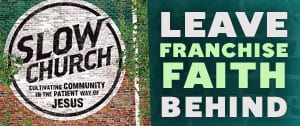
Instead of asking, “what is your book about,” I’m going to ask the question that’s behind that question. And that unspoken question is, “how are readers going to benefit from reading your book?”
John Pattison: We have two primary hopes for readers of Slow Church. The first, frankly, is that readers will feel a gentle dissatisfaction with “church-as-usual.” By that I mean approaches to church that reduce Christianity to a commodity that can be packaged, marketed, and sold; or to an individualistic faith that can be compartmentalized and managed from the privacy of our own homes. The second hope is that the book will fire readers’ imaginations with a rich vision of the holistic, interconnected, and abundant life together we believe we’ve been called to in Christ Jesus.
What is a “slow church” exactly?
John Pattison: Slow Church is inspired by Slow Food and the other Slow movements to re-think the way in which we live life together in our church communities. The various Slow movements – Slow Food, Slow Money, Slow Cities, etc. – differ in subject and scope and strategy. What they have in common, however, is their opposition to what the sociologist George Ritzer describes as “McDonaldization” – the process by which the principles of the fast-food restaurant (efficiency, predictability, calculability, and control) have come to dominate more aspects of modern life.
We think McDonaldization has proven alluring even to American church life. Well-meaning churches often emphasize quantity over quality, programs over people, control over empowerment, the sanctuary over the neighborhood, and efficiency over the good, long labor of spiritual formation. All in the name of “productivity.” There’s nothing inherently wrong with efficiency, predictability, or even speed. But as standards they often undermine authentic presence – with God, with each other, and with our places.
In contrast, the focus of a “slow church” isn’t on finding the most efficient way to grow. It’s final standard is faithfulness. A slow church comes to understand itself as a vital part of God’s reconciling mission. It involves an attentiveness to what God is doing around us, and yet that attentiveness is nurtured over time and in place. This is usually long, slow work. But what’s so great about this is that everything matters. Even the down times, the dailiness of apprenticing ourselves to Jesus, all the quotidian details of life, the smallest acts of hospitality or generosity – they are all being woven together by God into the fabric of God’s Kingdom.
McDonaldized church growth strategies remind us of conventional farming practices that focus on the rapid growth of the crop or animal, often at the expense of quality, the land, and long-term sustainability. Slow Church takes a more organic approach, focusing instead on the health of the “soil,” which is the local church and its neighborhood.
Please give a few examples of a “slow church” – including the kinds of gatherings they have during the week, the types of things they do for community life, and finally, the way leadership and decision-making operate.
John Pattison: First, to be clear, I don’t know of any church out there that refers to itself as a “slow church.” Some of the articles about our book have speculated about the possibility of a “Slow Church movement.” Chris and I don’t think of it like that. We think what’s needed now is not another movement, but rather a robust and diverse conversation. Slow Church is just Church. What we do is try to provide a metaphor, some stories, and a few key practices and convictions that can help disentangle the church from some of the worst aspects of Fast Life. We also wanted to affirm churches who are doing the patient, often un-sexy, rarely celebrated work of being faithfully, patiently rooted in their communities.
With that caveat, let me tell you about some of the churches whose stories we tell in the book:
Some gather on Sunday morning, others throughout the week. Some are small and meet in living rooms. Another – Salem Alliance Church in Salem, Oregon – is quite large. Most are somewhere in the middle. In addition to worship, several churches we highlight gather to eat together and talk together – important formative slow church practices.
Many of these faith communities have doubled down on their relationships with their neighborhoods, making the countercultural decision to not move to the suburbs in search of cheaper land and more abundant parking. At still other churches, members have moved closer to the church so they can live life more intimately with neighbors.
While these churches have many values in common (gratitude, hospitality, and more), the ways in which those values work out practically are indigenous from one diverse context to the next – another important aspect of Slow Church. This is true even of leadership and decision-making. Some operate by consensus; others don’t. Most, however, have a deep commitment to trust-building that is developed in conversation.
How is your book different from the many other books on ecclesiology out there today?
Chris Smith: Well, hopefully ours is one that ordinary Christians want to read! Ecclesiology is not something that is talked about much outside of seminaries, and that’s a huge problem. One of our main goals was to write a book about ecclesiology, about the church, that ordinary church members would want to read and talk about with others in their church. Neither John nor I are pastors, church planters, or professional theologians. In fact, we say in the book’s introduction that we are “amateurs” in the root sense of that word, which implies doing something out of love for it. We love the church.
We hope Slow Church ignites a much-needed conversation about ecclesiology that is rooted where it matters the most: in our local churches. The community of God into which we’ve been called is a social reality. But our formation as Westerners—including the way we read scripture (for example, all those plural “you”s that we take as singular)—makes us uncomfortable talking about the church that way. I think though our book is a timely one: as modernity crumbles, people are hungry for community, for an alternative to the alienation and the isolation that we find ourselves in amidst a culture formed by centuries of individualism.
Give us two or three insights from the book that would be helpful to Christians.
Chris Smith: First, and most importantly, church matters! Local communities of Christ’s followers gathered in their particular places—these are at the heart of what God is doing in the world. Church isn’t just a building or a Sunday morning service, a place we go or an event we attend to get spiritually recharged. From Israel, to the apostles, to Pentecost, and to the present day, God is gathering a people who in their life together bear witness to the good news of God’s reconciling love.
And a church is more than its pastors or the sum of its leadership. As Paul emphasizes in 1 Cor. 12 and elsewhere, every person has a role to play in the functioning of the local Body, and gifts that facilitate that role. If we believe God is reconciling all things, then there is room for the gifts and skills of everyone—not just pastors and musicians and Sunday School teachers (as important as these are), but also plumbers and entrepreneurs and artists and real estate agents and professors and everyone.
Second, our call as communities of God’s people is not to see how big, wealthy, or powerful we can become. Our call is to a deeper, more vibrant, more faithful life together—shaped by the reconciling love of God. Of course, there’s always the temptation to swing too far in this direction and forget that church is not an end in itself, but also means to bear witness to our neighbors. We need to be engaged with our neighbors so they can see God’s love and healing power at work in our midst.
Have you gotten any push-back on the book? If so, explain and respond.
Chris Smith: I think the biggest pushback that we have gotten is that suggestion that slow church is a sort of elitist luxury. (Interestingly, this is also the most common critique leveled at the Slow Food Movement.) The most thoughtful of these critiques came early on from James K.A. Smith, in an article entitled “Knitting While Detroit Burns?”, in which he says:
And let’s be honest: Slow and local is a luxury. Because slow means waiting, and those suffering injustice can’t wait. While Christian eschatology teaches us to wait in hope, that waiting is a kind of holy impatience, the sort that infused Dr. Martin Luther King, Jr.’s excoriating reminder that often “Wait” just means “Never.”
This critique came out several months before the book did, but I have argued that it is a straw man. One of the central tenets of slow church, as John and I described it, is that God is reconciling all creation and we are ambassadors of that reconciliation. Thus, passivity is not an option. What we’re concerned about is how we engage.
While we can sympathize with the sort of frantic activism that responds to crises with the mentality of “We’ve got to do something!,” careless action can often do more harm than good. John and I maintain that we need certainly need to be engaged and act, but we need to do so out of reflection that originates in our local church communities. Slow, for us, doesn’t always mean that we have to literally move slowly.
Rather, it must that we must always act attentively, and if we are becoming engaged in new ways, we might literally be slow, but the more we continue to be engaged, our action can become swifter and more skillful. It’s like riding a bike, or any activity that we mature at over time, we’ve got to start slow and be persistent, and if we are, then we will be able to act well with more urgency.
When a reader finishes your book, what will they “take away” from it?
Chris Smith: The final chapter of the book is on reimagining church as dinner table conversation, and that’s the image that we want to leave kicking around the reader’s head as he/she sets the book down. This image is, of course, a Eucharistic one, recalling the life of the early church in Jerusalem, a key facet of which was breaking bread together daily.
We don’t want churches to do away with their practices of Eucharist or communion, but we think that it is really important for churches – very intentionally and thoughtfully – to find ways to share regular meals together. Eating is an economic act, and in sharing a meal together, we are sustaining one another. Sharing meals also requires that we make economic decisions (like where is the food going to come from, and who is going to cook it, and who is going to clean up after the meal?) and brings our faith down from abstract theological convictions about God and the world to the concrete realities of day-to-day life.
Eating meals together is important not only as a way of sharing life and sustenance, but also for the space it affords us to talk together. Conversation is becoming a lost art in Western culture, (look at the failures in dialogue that prevail between parties in the US Congress, for instance), and our church communities should be an important place where we learn to talk – and to be – together. It is in conversation that we learn to discern together, working together to understand what God is up to in the world and how we as a particular group of people in a particular time and place follow God’s leading together, and how the gifts of every unique person in the church contribute to what God desires to do in our neighborhood.
Conversation is a vital practice for churches, and one that is not discussed enough; we want people to begin experimenting with it and sharing meals together is a great place to start, especially when we bear in mind that when we do so we are remembering self-denying, sacrificial life of Christ, and not just having a good time together.



